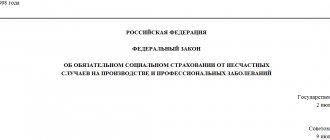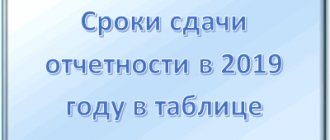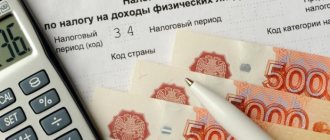Tax regime for individual entrepreneurs
It should be noted that the individual entrepreneur pays all taxes and social contributions, even if he works as a single person, i.e. for himself. But they are accrued not on wages, but on income. An individual entrepreneur cannot pay his own salary; he receives his own income.
An individual entrepreneur can use the general regime for paying the following taxes:
- Personal income tax at the rate of 13% of income.
- VAT.
- Pension Fund.
- Social Insurance Fund.
- Federal Compulsory Medical Insurance Fund.
Income tax is calculated on the amount of income minus expenses. If there are no documents confirming the costs, the costs are considered conditional in the amount of 20%.
Individual entrepreneurs also pay taxes such as transport, property of individuals, land and water.
The entrepreneur keeps records of his activities
Payments not subject to taxation:
- Material aid.
- For donation.
- Alimony.
- Scholarships.
- Severance pay.
- Amount for damage caused in the form of injury.
- Business trips.
- Compensation.
General provisions for calculating payroll tax are specified in Article 210 of the Tax Code of the Russian Federation. Non-taxable income is discussed in Article 217. The regulation of tax deductions is set out in Articles 218–221. The nuances regarding the personal income tax rate are set out in Article 224.
Personal income tax: calculation sequence
To calculate the amount of income tax on wages, the following algorithm is used:
- The salary is calculated in full.
- Highlight tax-deductible co-payments.
- The tax payer status is determined.
- The right to charge the tax of an individual taxpayer is justified.
- The tax deduction and the non-taxable portion of the income are subtracted from the total income.
- The final result is that part of the income from which personal income tax is calculated.
Rights of residents and non-residents
If the taxpayer is a resident of the Russian Federation, 13% is charged on his income. For non-residents - 30%.
A citizen who stays within Russia for 183 days in one calendar year is considered a resident. The following categories correspond to this status:
- Citizens of Russia.
- Foreigners.
- Stateless individual.
It follows that a resident can be a person with different citizenship, regardless of his permanent place of residence.
At the end of each year, it is necessary to clarify the status of the tax payer in order to correctly calculate the amount of income tax.
Features of settlements with foreigners
The percentage of personal income tax for a foreign worker depends on his status in the Russian Federation:
- resident;
- non-resident;
- refugee;
- temporarily staying on the territory of Russia.
For reference: a foreigner has non-resident status if he stays in Russia for less than 184 days over 12 calendar months. If a foreigner stays in the country for 184 days or more, and his stay is not interrupted, then he receives resident status. Continuous stay in the country is documented.
How much personal income tax a foreign citizen working in the Russian Federation will pay depends on the specifics of the work, qualifications and the country from which he came to work.
Income tax on resident foreigners is levied at the same rates as on the income of Russian citizens. To confirm the status, the foreigner provides supporting documents to the accounting department at the place of work.
There are exceptions for foreign workers. A foreign resident of the Russian Federation who is an employee of a Russian company actually works abroad. The income received by him is of the type of income received from foreign sources. He pays taxes on them himself. If a foreigner is not a resident of the Russian Federation and receives remuneration for work outside the Russian Federation, then personal income tax is not charged.
Tax deductions
When calculating income tax, it is necessary to clarify whether tax deductions are applicable to a particular individual.
The following types of deductions exist:
- Standard. Benefits in the amount of 500 rubles. – participants of the Second World War and military operations; disabled people of І and ІІ groups; Heroes of the USSR and the Russian Federation; retired military; victims of the Chernobyl accident; 1,400 rub. are due to parents of minor children; 3,000 rub. – liquidators of the Chernobyl Nuclear Power Plant and PA Mayak with disabilities; parents or guardians of 3–4 children or a child with a disability; persons who became disabled during military operations; nuclear weapons testers.
If you fall into several categories, a larger deduction amount is taken into account. Standard deductions are taken by the employer.
- Social.
- Professional.
- Property.
To obtain a document confirming the right to deduction, you need to submit a declaration of income to the Federal Tax Service based on the results of the past year and present documents on expenses.
The calculation of the tax base is based on the following income:
- Salary.
- Rates.
- Premium.
- Allowances.
- Odds.
In a situation where an employee did not have earnings due to vacation or illness, income tax for this period is calculated based on average earnings.
Personal income tax is calculated for contractor employees in accordance with the general procedure.
To calculate salary tax, you will need a 2-NDFL certificate. It is issued for the period worked (one year or six months) and contains the following information:
- About the employer.
- About the employee.
- Total and monthly income.
- Code values of deductions.
- Personal income tax amount.
This certificate is issued by the company’s accounting department within 3 days, certified by the signature of the boss and the company’s seal. No corrections are permitted in this document.
Certificate 2-NDFL is needed to obtain a large bank loan or a mortgage loan.
Sample certificate 2-NDFL
KND form code: 115 10 78
Documents for obtaining a tax deduction for individuals
For each type of tax deduction, the tax office requires a separate package of documents, and in some cases requires compliance with certain deadlines.
To return funds for social deductions, the 3-NDFL declaration must be submitted no more than 3 years from the year in which taxes were paid and expenses were incurred, for example, on training or a complex operation.
In the case of the latter, it is necessary to prepare the following documents to obtain a tax deduction for treatment:
- Copies of payment documents (checks, receipts), certificates and treatment agreement (if the clinic is private), passport, work book, TIN certificate
- Application for tax deduction
- Declaration 3-NDFL
- Certificate of work form 2-NDFL
If expensive treatment was carried out, you need to prepare a certificate stating that the patient was required to purchase medications independently, in accordance with the contract for the provision of services.
You can also issue a refund if a relative is treated. For example, for a tax deduction for pensioners for treatment, you also need to provide a copy of your birth certificate to confirm that you are relatives (children), or other documents indicating family ties.
If you apply for a tax deduction for education, the list of documents is approximately the same and includes:
- Application for deduction, 3-NDFL declaration, 2-NDFL certificate, copy of TIN and passport
- Copies of: educational institution licenses, agreements for the provision of educational services, payment documents (receipts and checks)
The state is also obliged to pay back the mortgage in the form of a tax deduction. To do this, you must provide the following documents to the tax office:
- Original declaration 3-NDFL
- Russian citizen passport
- A certified copy of the real estate purchase and sale agreement (or equity participation agreement)
- Certificate of income of an individual, form 2-NDFL
- Application with bank account number for tax refund
- A certified copy of the certificate of registration of ownership (except in the case of shared participation)
- Copies of payment documents (for example: receipts, housing payment receipts)
- A notarized copy of the deed of acceptance and transfer of residential space
- A notarized copy of the loan agreement with the bank (in case of purchase through a mortgage)
- Original certificate of annual interest charged by the bank (for purchases with a mortgage)
Important:
The list of documents can be supplemented if the housing was purchased as joint ownership or self-construction. Also, the necessary certificates may change depending on the additions to the Tax Code, but the current package of documents is available on the inspection website.
In the case where an individual was engaged in improving housing conditions, a tax deduction can be issued for apartment renovation. To do this, you need to prepare not only documents for housing, but also certified copies of the contract with the repair team, checks and receipts for the purchase of materials.
After submitting the documents, the tax office has 3 months to conduct a desk audit. Then, within 10 days, the inspection must notify the applicant about the state of affairs regarding his issue. If everything is in order with the documents, the deduction is transferred to the account within 1 month.
Register now and get a free consultation from Specialists
Personal income tax for an employee with children
The income tax of an employee whose family has a child is calculated taking into account the standard deduction due to him. How to calculate the tax deduction due to an employee with children is determined by Article 218 of the Tax Code of the Russian Federation. The following documents are required for its calculation:
- Statement.
- Child metric.
- Certificate of full-time education of the child.
- Documents about disability.
- The second parent submits an application to waive such benefits.
The employer bases it on the employee's total taxable income. From the moment his income exceeds 280 thousand rubles, the tax base decreases every month:
- 1400 rub. for the first two children.
- 3000 rub. for the 3rd and subsequent children.
- 3000 rub. for a child with a disability.
- 3000 rub. for a full-time student until he turns 24 years old, if he has a disability of groups I and II.
Guardians, adoptive parents and trustees can also enjoy such benefits.
If the second parent refuses to receive the deduction or there is only one parent in the family, the benefit is accrued in double amount.
Parents have the right to a tax deduction from the first month of the child’s birth if he was born in the current year.
Tax deductions for personal income tax 2021
A tax deduction is an amount that is subtracted from your pre-tax income. When applying it, the taxable amount is reduced by the amount determined by the Tax Code for various situations.
The tax deduction is provided to citizens of the Russian Federation and residents who have income taxed at a rate of 13%.
There are deductions:
- standard;
- social;
- property;
- professional.
Table of standard deductions allowed for use in 2017:
The standard deduction for children in 2021 is applied monthly until the amount of income from the beginning of the year does not exceed 350 thousand rubles.
Social deductions represent a reduction in the tax base.
Personal income tax for single mothers and pensioners (with formulas)
There are a number of categories of workers who need social protection, in particular single mothers. They are provided with double benefits, at the moment: 2000 rubles. per child and 400 per employee. This amount is deducted from income and only the remainder is taxed.
There are no benefits for working pensioners when calculating personal income tax (Chapter 23 of the Tax Code of the Russian Federation). Standard approaches apply to this category, in particular tax deductions if the retired employee has the right to them. If, for example, the pensioner has a dependent child or the pensioner has a disability, the amount of accrued income tax will be reduced by the amount of the corresponding tax deductions.
Formula tax calculation:
The following formula will help you get the correct result of the income tax amount:
Personal income tax = RNB x NS/100, where:
RNB - size of the tax base:
NS - tax rate.
Usually, as a result of calculations, amounts in rubles and kopecks are obtained, which complicates further monetary transactions. In accordance with clause 4 of Article 225 of the Tax Code of the Russian Federation, the amount of tax must be presented in full rubles. The rounding process is carried out as follows: if the amount is presented in rubles with kopecks up to 50, then the kopecks are discarded, if more than 50, then the amount is increased by 1 ruble.
You can also use the following formula:
CH = OD - NV, where
SN - tax amount, OD - taxable income, NV - tax deduction.
Calculation examples:
Standard tax calculation . Employee Nikitin A.O. has an income of 50,000 rubles, interest rate 13%:
50,000 x 13% = 6,500 rub.
The monthly tax amount is 6,500 rubles.
Personal income tax including tax withholding . The same employee has a minor child, which means he enjoys a benefit in the amount of 1,400 rubles:
(50,000 – 1400) x 13% = 6,318 rubles.
The amount of tax calculated every month, taking into account the deduction, is 6,318 rubles.
Personal income tax on vacation pay . Employee Nikitin A.O. was paid vacation pay in the amount of 48,000 rubles:
48,000 x 13% = 6,240 rubles.
The tax on vacation pay will be 6,240 rubles.
Personal income tax from salary
All organizations conducting commercial activities in the country must withhold personal income tax from wages and other income of their personnel. The income tax rate depends on whether the employee is a resident or not.
Resident individuals pay personal income tax at a rate of 13%.
If an employee working for a company has been absent from the country for more than 183 days over the past year, he is considered a non-resident. The employer is required to deduct a 30% tax on the income of such persons.
On a note! If, due to a change in tax status, the employer withheld more personal income tax than required, the money can only be returned through the Federal Tax Service. But the company can count the overpayment of income tax against future payments.
Also, the following groups of foreigners work at a 13% tax rate, even if they are not residents of the country:
- highly qualified specialists;
- foreigners working without visas, under a patent;
- citizens of states that are part of the EAEU employed in the Russian Federation. These include Armenia, Kazakhstan, Kyrgyzstan and Belarus.
- foreign citizens who have received asylum in Russia;
- persons recognized as refugees.
The tax agent is required to regularly check the status of its employees. This is done every month, before wages are calculated. The final status is checked at the end of the calendar year, December 31.
It happens that during the year an employee was a resident of the Russian Federation, but on December 31 he changed his status. In this case, the accountant is obliged to recalculate personal income tax from 13% to 30% for the entire previous year.
How to calculate personal income tax from wages
Income tax for Russian employees is calculated as follows:
- Add up all the income received by the employee, including bonuses, cash incentives, etc.
- From the resulting amount, subtract the expenses from which the tax must be returned (for example, social deductions).
- Multiply the personal income tax rate by the resulting amount (for residents - 13%, for others - 30%).
Let's give an example. Anna Nikolaevna Stepanova received a salary of 30,000 rubles and a production bonus of 10,000 rubles in February. The employee did not leave the country over the past year and did not file a deduction. For Anna Nikolaevna, personal income tax will be calculated as follows: (30,000+10,000)*13%=5,200. And Stepanova will receive 40,000-5,200=34,800 rubles.
If Stepanova had lived abroad for more than six months, and then arrived and got a job, the employer would have calculated personal income tax at a different rate - 30%. The personal income tax calculation would look like this: (30,000+10,000)*30%=12,000 rubles. And at the box office Anna Nikolaevna would have received 40,000-12,000 = 28,000 rubles.
To calculate income tax, you can use another formula:
Total amount of personal income tax from the beginning of the year – personal income tax withheld for the period from the beginning of the year to the previous month = Tax for the current month
When calculating personal income tax, pennies are never taken into account, only rubles. You should round like this:
- if there are less than fifty kopecks, there is no need to write them down;
- if there are more than fifty kopecks, you need to round the amount up.
Should an employee working outside the country pay tax?
Russian organizations do not need to withhold personal income tax from employees who are employed by the company and receive monetary remuneration, but live in another country. This is explained by the fact that wages paid are considered income received outside the Russian Federation. Therefore, the employing company in this case will not be recognized as a tax agent.
On a note! If a remote worker lives abroad for more than 183 days, his wages will not be subject to income tax. But, if the employee is a resident of the country, he must pay personal income tax to the state himself.
Changes in accrual in 2021
The main news for citizens of the Russian Federation is that taxes are not increasing. The basic rate remains the same - 13%. The highest rate of 35% is for those who receive high interest rates from bank loans, expensive prizes and winnings. For non-residents, 30% and 15% remain, depending on the source of income.
A 9 percent rate is used for the following types of income:
- If a resident of the Russian Federation receives income in the form of dividends from equity participation in the operation of the enterprise.
- Interest on bonds (before January 1, 2007) with mortgage backing.
Changes for 2021
There are no major changes to income tax in 2021. Thus, the taxpayer can use the deductions provided to him by law and sum them up, if possible. However, standard deductions cannot be counted as one whole, with the exception of benefits for raising children.
The income tax deadline is April 30.
Interest rates have also remained unchanged, ranging from 13, 9, 15 or 35 percent, depending on a number of important factors. Starting this year, personal income tax will be collected on payments for sick leave checks or temporary disability certificates due to health conditions or for caring for a patient during his treatment.
If an employee goes on vacation or takes sick leave, then the tax is calculated according to the average salary, and not according to the minimum, as was previously the case.
back to menu ↑
TAX CALCULATION METHOD. Personal income tax
Registration and retention
Income tax is calculated and calculated, and accounting entries are made:
Debit70 Credit68 - income tax subaccount - deduction from the earnings of an ordinary employee.
Debit76 Credit68 - income tax subaccount - deduction from the contractor's income under the contract.
Sample accounting entries with personal income tax:
Applicable to all forms of enterprise ownership
Insurance and social contributions
In addition to personal income tax, various insurance and social contributions are deducted from wages (Federal Law No. 212 “On insurance contributions to the Pension Fund, Social Insurance Fund, Federal Compulsory Medical Insurance Fund”). In 2021, changes have occurred: contributions to the Social Insurance Fund will not exceed 718 thousand rubles, pension contributions will not exceed 796 thousand rubles. (PRF Resolution No. 1265). There are no restrictions for the FFOMS.
Amounts of insurance premiums:
- Pension - 22%, (preferential - 20%), contributions exceeding the limit - 10%).
- FSS - 2.9%.
- FFOMS - 5.1%.
Ways to minimize taxes
No matter how law-abiding the employer is, he is interested in making as few payments as possible on wages and, just like the employee, is interested in the minimum number of deductions from wages. To minimize the amount of tax payments, you can use the following instructions :
- It is advisable to hire according to the GPA. In this case, the employee becomes an individual entrepreneur who applies a simplified tax system. The income tax will be only 5% and 150 rubles. pension contribution. This is much less than personal income tax - 13% and insurance premiums up to 35%. There is another trick - show zero income, and then only the pension fee will remain.
- If you replace your salary with the payment of dividends from shares, you will not have to pay a single social contribution, but will only have to pay the 9% tax rate on dividends. For this purpose, another legal entity is registered, and the employees are registered as the founders of the company.
- Instead of an employment contract, a lease agreement is drawn up. Accordingly, not the salary is paid, but the rent. Thus, the income tax will be only 6%.
- Each structural unit of the enterprise should be registered as a separate legal entity and switch to a simplified taxation system. An agreement for the provision of services is concluded between the established companies. In such a situation, the main enterprise will pay lower rates for insurance premiums.






